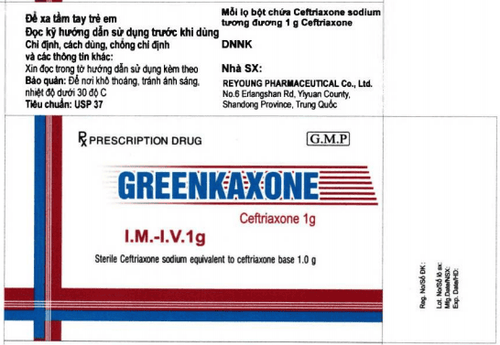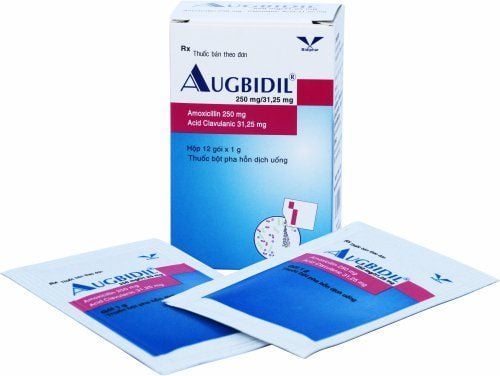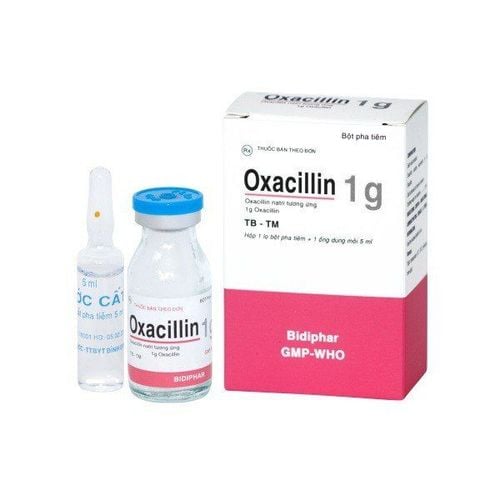This is an automatically translated article.
Cefobamid is prepared as a powder for injection, with the main ingredient being Cefoperazone. The drug is used in the treatment of certain infections caused by strains of bacteria sensitive to the main active ingredient in the drug.
1. What is the effect of Cefobamid?
1 vial of Cefobamid powder contains 1g of Cefoperazone (as Cefoperazone sodium). Cefoperazone is an antibiotic belonging to the 3rd generation cephalosporin group, which has bactericidal effects thanks to its ability to bind to the bacterial cell wall. Cefoperazone can bind to one or more penicillin-binding proteins, thereby inhibiting cell wall synthesis of growing and dividing bacterial cells. From there, it causes cell death.
Cefoperazone is effective against many strains of gram-negative aerobic bacteria, gram-positive aerobic bacteria, some anaerobic bacteria,... Cefoperazone is very stable against beta-lactamases formed by most bacterial strains. gram-negative but susceptible to hydrolysis by some beta-lactamases.
Indications for use of Cefobamid: Treatment of some serious infections caused by susceptible strains of bacteria and bacteria resistant to other beta-lactam antibiotics such as:
Infections of the biliary tract; Upper respiratory tract infections; Subcutaneous and soft tissue infections; Infections of bones, joints, kidneys, urinary tract; Pelvic inflammatory disease, obstetric and gynecological infections; Peritonitis, intra-abdominal infections; Sepsis . Contraindications to the use of Cefobamid:
Patients who are allergic or sensitive to the active ingredients of the drug; People who are allergic to any cephalosporins; The patient has a history of severe allergy to any beta-lactam drug.
2. How to use and dose of Cefobamid
2.1 How to use Cefobamid is used for deep intramuscular injection, intermittent infusion (about 15 - 30 minutes) or continuous infusion. A slow direct intravenous injection can be performed over 3 to 5 minutes, but a rapid direct intravenous injection is not recommended.
When dissolving Cefoperazone at concentrations exceeding 333mg/ml, shake vigorously and for a long time, the maximum solubility is approximately 475mg/ml.
How to make the drug:
Deep intramuscular injection into large muscle mass such as the front thigh or gluteal muscle. It is recommended to mix 1g of the drug with 3ml of distilled water. It is possible to pre-mix with 3ml of distilled water, shake well until the powder is completely dissolved, then add 1ml of 2% lidocaine solution, shake well; Intermittent intravenous infusion: Mix 1g of the drug in 5ml of one of the following fluids: Dextrose 5% or 10%, Sodium chloride 0.9%, Normosol R, Dextrose 5% and Sodium chloride 0.9%, distilled water , Dextrose 5% and Sodium chloride 0.2%. Then, dilute to 20-100ml of one of the following infusion fluids: Dextrose 5%, Dextrose 5% and Ringer lactate, Dextrose 10%, Ringer lactate, Sodium chloride 0.9%, Dextrose 5% and Sodium chloride 0. .2%, Dextrose 5% and Sodium chloride 0.9%, Normosol R 5%. If using distilled water, do not use more than 20ml. For continuous infusion, 1g of the drug should be diluted in 5ml of distilled water and added to the appropriate infusion solution. *Note: After making a solution, Cefobamid does not need to be protected from light. Reconstituted solutions will still be effective after 24 hours at temperatures below 25°C; 5 days if stored in the refrigerator at a temperature below 5°C; for 3 weeks if frozen. After freezing, the thawing solution is stable for 48 hours at room temperature or 10 days if refrigerated.
2.2 Dosage of Cefobamid The dosage of Cefobamid is referred to as follows:
Adults: For mild and moderate infections, the usual dose is 1-2g, every 12 hours. In the case of patients with severe infections, the dose can be increased to 12g/day, divided into 2-4 doses; Patients with renal impairment: Cefobamid can be used at the usual dose without needing to adjust the dose. If the patient shows signs of drug accumulation, the dose should be reduced accordingly; Patients with hepatic impairment: The dose for patients with liver failure or biliary obstruction is not more than 4g/24 hours or the dose for patients with combined liver failure and renal failure is 1-2g/24 hours. If higher doses are used, plasma concentrations of cefoperazone should be monitored; The course of Cefoperazone use in the treatment of infections caused by group A beta-hemolytic Streptococcus should continue for at least 10 days to prevent the risk of rheumatic fever or glomerulonephritis; Patients on hemodialysis: It is necessary to have an appropriate regimen of cefobamid drug use after dialysis; Children: Although the safety of Cefoperazone in children has not been established, it has been used intravenously in infants and young children at doses of 25-100mg/kg body weight every 12 hours. Due to the toxic nature of benzyl alcohol to neonates, the infant should not be administered intramuscularly with a solution containing benzyl alcohol (bacteriostatic). Overdose: When using Cefobamid in overdose, patients may have manifestations such as increased neuromuscular excitability, convulsions (especially in patients with renal failure). The management of overdose should consider the possibility of multiple drug overdoses, drug interactions, and unusual pharmacokinetics in the patient.
Management of overdose usually includes protection of the patient's airways, ventilatory support, and fluids. If the patient has a seizure, the drug should be discontinued, and anticonvulsant measures may be used if clinically indicated. Hemodialysis can help remove drugs from the blood. In addition, the majority of treatment measures for overdose are supportive or symptomatic.
3. Side effects of the drug Cefobamid
When using Cefobamid, patients may experience some side effects such as:
Common: Diarrhea, maculopapular skin rash, positive Coombs test, transient eosinophilia; Uncommon: Reversible neutropenia, thrombocytopenia, hemolytic anemia, fever, skin pruritus, urticaria, transient pain at the site of intramuscular injection, phlebitis at the site of infusion; Rare: Convulsions (if high doses are used and the patient has impaired renal function), restlessness, headache, nausea, vomiting, hypoprothrombinemia, erythema multiforme, membranous colitis pseudo-cholestatic jaundice, Stevens-Johnson syndrome, mild elevations of ALT and AST, nephrotoxicity with transient elevation of creatinine/uremia, arthralgia, interstitial nephritis, serum sickness, Candida, anaphylaxis, Hypersensitivity reactions,... When experiencing side effects of Cefobamid, the patient should immediately notify the doctor. In the event of a severe allergic or hypersensitivity reaction, the patient may receive supportive therapy (maintenance of ventilation, administration of oxygen, epinephrine, intravenous corticosteroids).
For mild cases of pseudomembranous colitis, it is usually enough to just stop taking the drug. In case of moderate and severe pseudomembranous colitis, the patient should be considered for the use of fluids and electrolytes, protein supplements, and treatment with oral metronidazole. If the patient has convulsions, Cefobamid should be discontinued and anticonvulsants may be used (if clinically indicated).
4. Be careful when using drugs
Before starting treatment with Cefoperazone, the patient should inform the doctor about the history of allergy to cephalosporins, penicillins or other drugs; Hypersensitivity cross-reactions (including anaphylaxis) have occurred in patients allergic to beta-lactam antibiotics. Therefore, Cefoperazone should be used with caution, monitored for symptoms of anaphylaxis during the first administration, and available to treat anaphylaxis if the patient has previously been allergic to penicillin. However, with Cefoperazone, the rate of cross-sensitivity to penicillin is quite low; Long-term use of Cefoperazone may result in overgrowth of non-susceptible strains of bacteria. Therefore, it is necessary to monitor the patient's health carefully. If the patient has a superinfection, cefobamid should be discontinued; There have been cases of pseudomembranous colitis with the use of broad-spectrum antibiotics. Therefore, patients taking Cefobamid should be aware of the risk of this disease and should be treated with metronidazole for patients with severe diarrhea associated with antibiotic use. Caution should be exercised when prescribing broad-spectrum antibiotics to patients with gastrointestinal disease, especially colitis; Cefoperazone contains an N-methylthio tetrazol chain - a structure related to hypoprothrombinemia. Hypoprothrombinemia has occurred in patients receiving cefoperazone but has rarely caused bleeding. Prothrombin time should be monitored in patients at risk of hypoprothrombinemia, using vitamin K if necessary. In particular, it is necessary to closely monitor prothrombin levels in patients with malabsorption or receive parenteral nutrition, if necessary, add vitamin K; Currently, there is not enough research information on the use of Cefoperazone in pregnant women, so the drug should only be used for this subject when absolutely necessary; Cefoperazone is excreted in breast milk at low concentrations, with almost no effect on the nursing infant. However, care should be taken if the child has diarrhea, thrush and a rash. It is best for nursing mothers to consult a doctor before taking Cefoperazone; Because Cefobamid can cause convulsions and headaches, caution should be exercised if the drug is used to drive or operate machinery.
5. Cefobamid drug interactions
Some drug interactions of Cefobamid include:
If you drink alcohol within 72 hours of using Cefoperazone, patients may experience disulfiram-like reactions with manifestations such as skin flushing, headache, sweating. , nausea, vomiting and rapid heart rate; Concomitant use of aminoglycosides and certain cephalosporins may increase the risk of nephrotoxicity. Although no interaction with Cefoperazone has been observed to date, it is still necessary to monitor the patient's renal function, especially in patients with renal failure who are taking Cefoperazone and aminoglycosides concurrently; The antibacterial activity of aminoglycosides and cefoperazone may be synergistic against some gram-negative bacteria. When combining these drugs, it is necessary to determine the susceptibility of the bacteria to the combined activity of the drug; Concomitant use of Cefoperazone with heparin and warfarin may potentiate the hypoprothrombinemic effect of Cefoperazone; There is a physical incompatibility between cefoperazone and aminoglycosides. If two drugs are used, they should be used separately. When prescribed Cefobamid, patients should strictly follow the doctor's instructions to ensure the best treatment effect and significantly reduce the unpredictable events that may occur.
Please dial HOTLINE for more information or register for an appointment HERE. Download MyVinmec app to make appointments faster and to manage your bookings easily.













